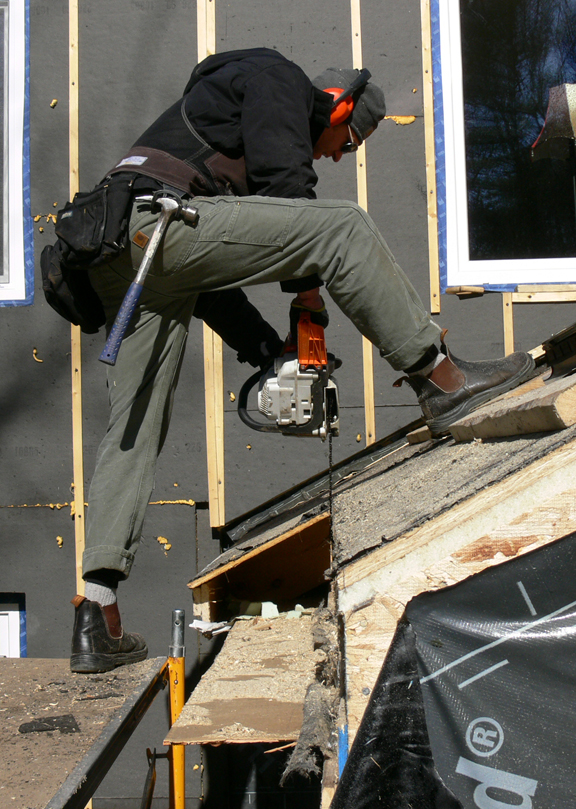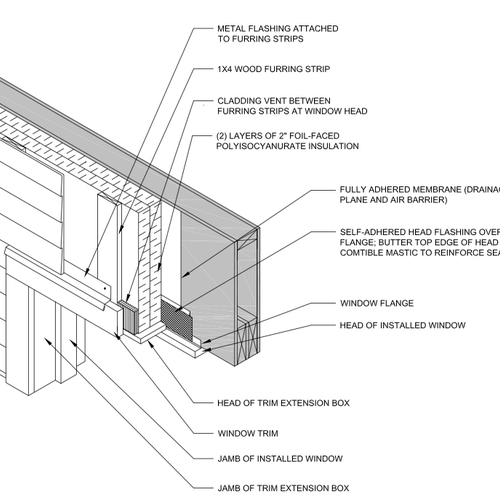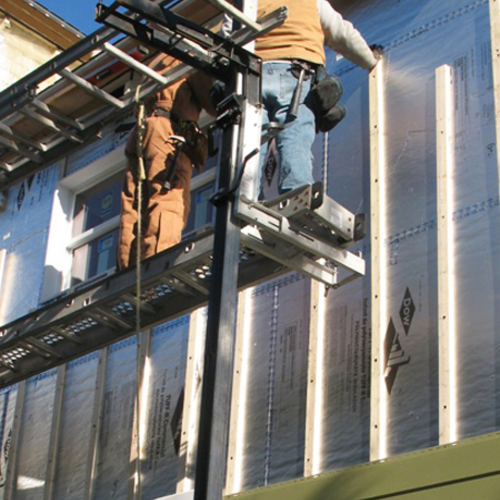
Image Credit: Richard Perry
When workers need to insulate the walls and roof of an existing building with exterior rigid foam, it often makes sense to cut off the roof overhangs first. With the eaves and rakes removed, wrapping the building in rigid foam is a snap. The missing roof overhangs can later be rebuilt by scabbing the necessary framing on the outside of the foam.
First described by Brian Marshall and Robert Argue in a 1981 book, The Superinsulated Retrofit Book, this method was dubbed the “chainsaw retrofit” technique by Rob Dumont and Harold Orr, the superinsulation pioneers who cut off the eaves and rakes of a ranch house at 31 Deborah Crescent in Saskatoon in the summer of 1982.
Although Orr refers to the Deborah Crescent project as a “chainsaw retrofit,” he admits that they never used a chainsaw on the job. “We used a circular saw to cut the framing — the cut was about 2 1/2 inches deep,” Orr told me. “We finished the cuts with a handsaw.”
In search of a real chainsaw retrofit
While attending the recent NESEA conference in Boston, I ran into Christian Corson, the builder responsible for a celebrated Passivhaus in Knox, Maine. Corson told me that he was now working on a chainsaw retrofit project.
“Have you finished cutting off the eaves yet?” I asked Christian.
“No, we’ve just started the job,” he told me.
“I’ve always wanted a photo of a builder tackling a chainsaw retrofit with an actual chainsaw,” I told Christian. “How about using a chainsaw and sending me the photos?”
Get out the Stihl
Like most Maine builders, Corson has a chainsaw, and he was happy to oblige. Corson recently sent me an e-mail that opened with two rhetorical quesitons: “Is it 1982, Saskatoon, Saskatchewan? Or 2012, Northport, Maine? Here are some pictures of…
Weekly Newsletter
Get building science and energy efficiency advice, plus special offers, in your inbox.

This article is only available to GBA Prime Members
Sign up for a free trial and get instant access to this article as well as GBA’s complete library of premium articles and construction details.
Start Free TrialAlready a member? Log in














12 Comments
Warning!
Cutting chains cross-cut like a hot knife through butter but do not like steel.
If you hit a nail, gang-nail plate or other:
The best case scenario is that you will wreck the cutting teeth and have to replace the chain.
Worst case scenario is that the chain could break, come loose and do some serious harm.
I would consider wearing proper safety gear including cutting chaps and a helmet with face guard.
Passivhaus in Knox, Maine
Christian,
Somehow I missed the blog about your Passivhaus
maybe because it was a "News Blog" and was not on the Home Page for very long.
https://www.greenbuildingadvisor.com/blogs/dept/green-building-news/striving-passivhaus-affordability
I just want to add to the Kudos
Kudos to you... very, very nice
Do you have links to any more photos,details or info about the Knox project?
Response to John Brooks
John,
Thanks for reminding other readers about Richard Defendorf's excellent news stories. For others who may be concerned that they missed a bunch of interesting articles, here is a link to the page listing Richard's news stories:
https://www.greenbuildingadvisor.com/blogs/dept/green-building-news
lucas
Lucas, Thanks for the concern.
I've had some close calls...
Christian,
I like your image.
I remember long road trips - rolling around, reading Archie comics and enjoying all the space in the back of my parent's station wagon.
Also, I second John's kudos about the Knox project.
nice vertical cuts--you made
nice vertical cuts--you made that look a heck of alot easier than it really is...about the scabbing deal--i guess you don't need hurricane clips as the scabbed on eaves/rakes are 'detachable' like a lizard's tail....how do you exactly "scab" the boards on? long stainless decking screws through the rafter end?
Response to Deniz Bilge
Deniz,
A good published detail showing scabbed-on soffits can be found in a JLC article, "High-Performance Homes On A Budget," by John Abrams. While the detail does not include exterior foam, it demonstrates the principle.
thanks martin
Thanks Martin, that's pretty cool.
Detail for scabbed-on rake over exterior foam
Hi Martin,
Any chance you have a cross-section view or details you could share for scabbed-on rake overhangs that are applied over exterior foam insulation? BSC refers to this technique in their case study for the Millbury Cape DER project, but doesn't provide much detail. I believe in the BSC technique the roof sheathing extends to support the rake overhang.
Many thanks,
Ewan
Response to Ewan Smith
Ewan,
Sorry -- I don't have a detail to share. But If I needed to install scabbed-on rake overhangs, I would build a series of boxes, and attach the boxes through the foam to the last rafter with long bolts or threaded rod.
Response to Martin
Hi Martin,
Thanks for your reply... appreciated.
I'm looking to add ~10" rake overhangs on a Cape Cod style home, and had some concerns about the overhangs "drooping" if scabbed-on over foam insulation on the walls. Your suggested technique makes sense.
Thanks again.
Ewan
Speaking of Chainsaws and the 1970s
At age 22, prior to going to architecture school, I worked at the University of California, San Francisco Dental School. One day a builder who had been using a chainsaw when the chain broke came for an evaluation by one of the top oral surgeons there. The builder had a terrible deep gash across his face that took off half his nose and gouged his oral cavity. It was truly, truly horrific. Made me view chain saws very differently! And led me to think you really always should use face protection. But, hey, it's up to you!
Bill
Log in or become a member to post a comment.
Sign up Log in